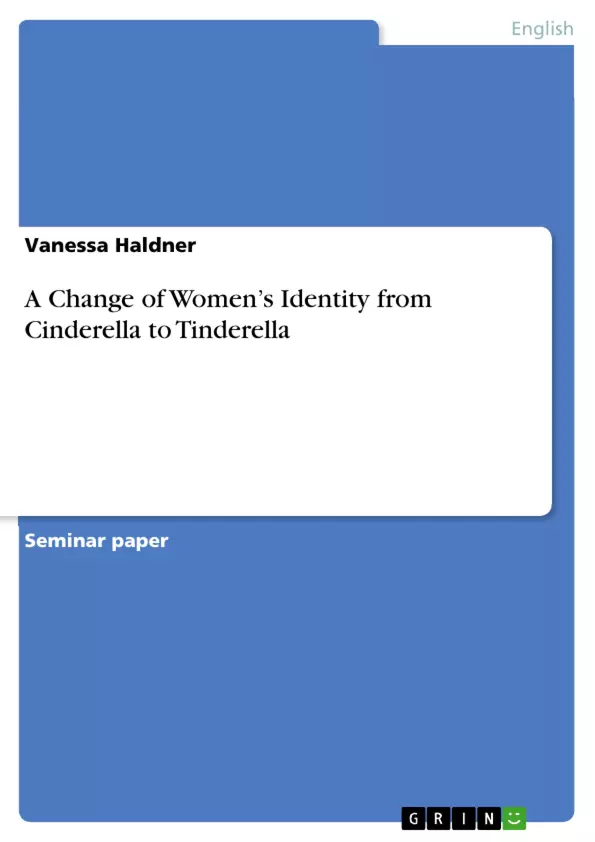The study examines the changing images and the modern role and self-understanding of women through analyzing motifs in Charles Perrault’s Cinderella or The Little Glass Slipper and in the short video clip Tinderella, written and conceptualized by Emily Axford.
Cinderella was chosen because of the high number of gender-related aspects it contains. A comparison with Tinderella seems useful since it constitutes an example of a woman with a rather modern lifestyle. To give an overview about the debate on the exploiting effect of fairy tales, I like to introduce scholarly work concerning the topic by the authors Marcia R. Lieberman (Someday My Prince Will Come) and Linda T. Parsons (Ella Evolving: Cinderella Stories and the Construction of Gender-Appropriate Behavior).
The expected result would be a clear demonstration of changing gender identity and sexual self-determination. The examination of this topic is important since we are confronted with the current debate on gender identity and gender-related education. Our society recently discusses whether we need gendered roles and have to make a differentiation between sexes with regard to several social issues. Therefore, it is interesting to examine a possible influence on the origins of gender theories and their progress.
Inhaltsverzeichnis (Table of Contents)
- Introduction
- Theoretical Framework
- Marcia R. Lieberman: "Someday My Prince Will Come"
- Linda T. Parsons: "Ella Evolving: Cinderella Stories and the Construction of Gender-Appropriate Behavior"
- Analysis
- Portrayal in Charles Perrault's "Cinderella or The Little Glass Slipper"
- Portrayal in Emily Axford's "Tinderella: A Modern Fairy Tale"
- Conclusion
Zielsetzung und Themenschwerpunkte (Objectives and Key Themes)
This paper explores the changing images and self-understanding of women in fairy tales through a comparative analysis of Charles Perrault's "Cinderella or The Little Glass Slipper" and Emily Axford's "Tinderella: A Modern Fairy Tale." The analysis aims to demonstrate the impact of evolving social norms and values on the portrayal of female characters in fairy tales and their modern adaptations.
- The influence of fairy tales on the construction of gender identity and behavior.
- The role of beauty and appearance in fairy tale narratives and their impact on women's self-image.
- The significance of marriage as a defining event for female characters in traditional fairy tales.
- The emergence of more modern and independent female characters in contemporary fairy tales.
- The connection between fairy tales and the current debate on gender identity and gender-related education.
Zusammenfassung der Kapitel (Chapter Summaries)
The introduction examines the enduring relevance of fairy tales in contemporary culture and highlights their potential impact on societal norms and values, particularly concerning gender roles. The paper focuses on the evolution of the female character in fairy tales and how these adaptations reflect broader societal changes.
The theoretical framework section introduces the work of Marcia R. Lieberman and Linda T. Parsons, scholars who have critically analyzed the influence of fairy tales on the construction of gender-appropriate behavior. Lieberman, in her article "Someday My Prince Will Come," argues that traditional fairy tales perpetuate stereotypical feminine traits, emphasizing the importance of beauty, passivity, and dependence on male characters for happiness. Parsons' work "Ella Evolving: Cinderella Stories and the Construction of Gender-Appropriate Behavior" explores how Cinderella narratives reinforce traditional gender roles, emphasizing the importance of obedience, domesticity, and finding a suitable husband.
Schlüsselwörter (Keywords)
Fairy tales, gender identity, gender roles, female characters, Cinderella, Tinderella, beauty, marriage, social norms, cultural influences, contemporary literature, modern adaptations.
- Arbeit zitieren
- Vanessa Haldner (Autor:in), 2016, A Change of Women’s Identity from Cinderella to Tinderella, München, GRIN Verlag, https://www.grin.com/document/379199



